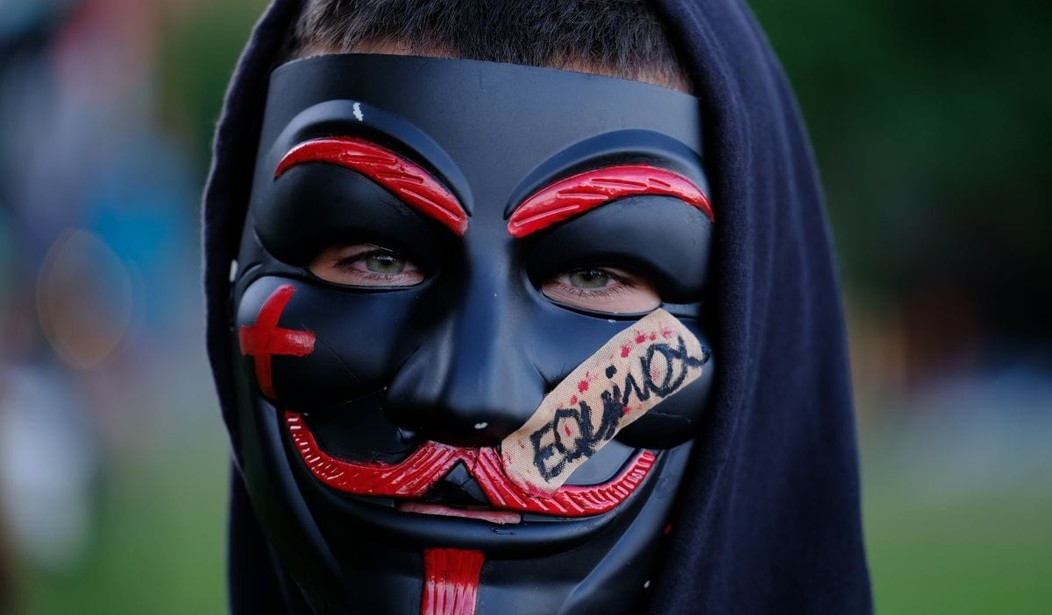On August 31, the website of The Atlantic published one of the most pretentious, mendacious, and – quite simply – downright preposterous articles to come along in a while. Written by Conor Friedersdorf, it was entitled “How to Distinguish Between Antifa, White Supremacists, and Black Lives Matter.”
Friedersdorf starts off with the claim that in the face of militant confrontations involving members of two or more groups of political activists, “millions of Americans feel pressure to pick a side, to support or denounce a faction, knowing that whatever they say about white supremacists, Antifa, or Black Lives Matter, they risk being criticized for failing to condemn violence on ‘their side,’ or for suggesting a false equivalence between groups.” Therefore, he adds, the question of the day is this: “How can a conflicted observer find clarity?”
To begin with, I would quibble about this opening assumption. If one gang of thugs clashes violently with another, both purportedly motivated by some ideology or other, how many ordinary Americans “feel pressure” to side with either of them based on the ideology they claim to be fighting for? Do they view thugs of any kind as being on “their side”? Do they worry all that much about “being criticized” for what they say or don’t say about such incidents?
Do they really have so much trouble finding “clarity” about such matters? Isn’t it kind of insulting, in fact, to suggest that they do? Don’t most of them, when they see such displays of mindless brutality on TV, simply shake their heads, think “a plague on both their houses,” and then resume going about their own business? Can it be that Friedersdorf is projecting his own concerns, priorities, and habits of thought as a member of the professional commentariat onto regular folks whose minds work in an entirely different way than he does?
In any event, the premise of Friedersdorf’s piece is that millions of Americans do yearn for clarity in such matters – and that they need somebody like Friedersdorf to figure such complex things out for them.
Here he is, then, to help them make their way through the fog. First, he advises that “[o]ne way forward is to distinguish between a group’s ends and its means.” He explains that the Against Malaria Foundation is “praiseworthy across the board” because it uses “morally unobjectionable means” to reach a positive end, while ISIS is totally abominable because it uses iniquitous means – rape, murder, pillaging – to attain a villainous objective, namely the establishment of a “repressive theocracy.”
Other cases are more complex: Lance Armstrong used shameful means (cheating) to achieve a respectable goal (victory in the Tour de France); conversely, Hitler took something intrinsically innocuous (the 1936 Olympics) to further an ignoble ambition (adding luster to the Nazi image).
True enough, I guess. And also as simple as can be – although Friedersdorf spells it all out laboriously, as if he’s presenting an exceedingly complex and subtle mathematical proof to a room full of morons.
The next part is where things get shaky. Friedersdorf offers this assertion: “different groups can choose equally objectionable means without becoming equivalent, because assessing any group requires analyzing their ends, not just their means.”
The piece then goes on for another couple of thousand words, but the argument made therein is easily and briefly summed up: violent neo-Nazis are wicked because they commit wicked actions to promote a wicked ideology; violent Antifa members, however, represent a “more complicated” ethical challenge, because they do bad things in the service of a “laudable” cause – namely, that of “resisting fascism.” Ditto violent Black Lives Matter members: they may wreak havoc and hurt people, but their “primary end” – “stopping unjust killings by police officers” – is virtuous.
Friedersdorf claims to be prepared to discuss and debate questions about the actual motives and ideologies of Antifa and BLM. He even admits that he is “unsure about how credible [Antifa’s] stated ends really are.” Well, then, if you seriously are unsure, shouldn’t you spend the remainder of your piece trying to figure out just how credible Antifa’s professed beliefs truly are?
For my part, I see no reason for uncertainty on this score: to me, it’s ridiculously obvious that Antifa is not anti-fascist but anti-freedom, determined to shut down speech it dislikes and prepared to use violence when doing so. It’s fascism posing as anti-fascism. Every sane American, of course, already knows this.
But Friedersdorf won’t even address that view. He insists that there’s a vital distinction between Antifa and Nazis – the former’s stated goals are laudable, the latter’s are depraved. I accept this point, and what it says to me is quite straightforward: Nazis are honest about their repellent goals and Antifa is dishonest (or self-deluding) about them. For me, this difference has no impact on the fact that both are equally repellent. Friedersdorf, though, has the opposite takeaway: for him, Antifa’s stated goals, however bogus, make it less objectionable than the Nazis or KKK.
The logic of this entirely escapes me.
Friedersdorf then finds an additional way to put Antifa on a higher shelf than the Nazis and KKK. While violence on both the left and right are deplorable, he maintains, right-wing violence has been more destructive than left-wing violence.
How does he back up this claim? First, he blithely categorizes Islamic terrorists as right-wing – entirely ignoring the fact that their allies and apologists in the West are overwhelmingly on the left. (His other violent right-wingers include Tim McVeigh and Dylann Roof.)
Second, he limits his purview to his own lifetime and, apparently, to America – which means he’s able to omit Mao, Stalin, Pol Pot, Ho Chi Minh, and Castro, among others. (Never mind the fact that many students of history consider Nazism – short for National Socialism – a left-wing phenomenon.)
Here’s Friedersdorf’s clincher: “historically, the KKK is the most prolifically violent terrorist group in United States history, while the Nazis are among the most murderous regimes in Western history. Folks on the right who don’t understand those who don’t see Antifa as equivalently dangerous might reflect on the body count as the reason for that viewpoint.” This is a remarkable line of argument, given that Mao’s and Stalin’s body counts both greatly exceeded Hitler’s. If we followed Friedersdorf’s cockeyed logic, we’d have to conclude that today’s neo-Nazis and Klan members are morally superior to Antifa.
Of course, we’ve heard all this before. In his determination to whitewash Antifa, Friedersdorf is playing the same old rhetorical games that the Western Left employed for decades to defend the Soviet Union and Red China. Yes, Stalin and Mao weren’t perfect; yes, the Gulag and Holomodor and Cultural Revolution were unpleasant; but Communism was still better than Nazism – because its claims for itself sounded so much nicer.
Who but a fool, a knave, or a prisoner of ideology could seriously make such a contention? What ordinary American could possibly be expected to buy it? And why is The Atlantic, a once-distinguished publication founded in 1857 under the editorship of James Russell Lowell, trying to sell it?









Join the conversation as a VIP Member